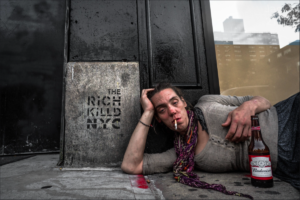Looking through Suzanne Stein’s work I noticed plenty of feelings that each of the pictures transmitted, going from delicacy to harshness. One picture that stands out to me is the “DSC07951.jpg” on the “New York Street 1” album, this picture locates us in New York City and the subject framed is a woman that I infer is in a homeless situation, based on the dust and tear on her skin and clothes; The subject poses while smoking a cigarette and a “Budweiser” Beer bottle stands on her right side , what capture my attention the most is the street art sign located on her left side, “The Rich Killed NYC”.
Suzanne Stein manages to say so much in one shot, and in “DSC07951.jpg” particularly, the social critique to the elitist “NYC” is right on spot. Picturing a homeless person that ended up on the streets thanks to extreme poverty, drug use, gentrification, disability etc., next to a sign stating how the rich people in New York has taken over the middle and the lower classes, talks to me about how hard it can be for a person to afford having a place to live in NYC, gentrification has spread into this city hurting the people that used to live in those “poor neighborhoods.” The Sadness and abandonment Stein captured on this image says a lot about of how the life of a person in this situation might be, it feels like the subject is tired but at the same time got used to this living like this.
Based on Steve McCurry “9 photo compositions”, Suzanne Stein Used the Rule of thirds by placing the subject’s body not directly in the center of the shot, she used instead the middle point between the wall and her hand, and her body is located to the right of the frame. The use of diagonals, as the women’s body is placed, and Leading Lines from the buildings wall, leads your eye to the message written, and her face, making this the focal point and getting the message across in a stronger way.





Recent Comments